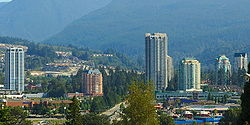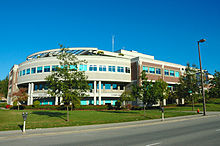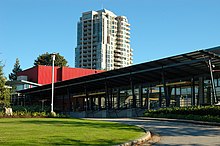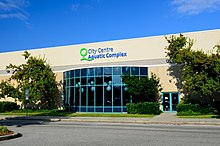This is an old revision of this page, as edited by El aprendelenguas (talk | contribs) at 02:13, 3 September 2008 (Reverted edits by 209.121.155.196 to last version by Me-123567-Me (HG)). The present address (URL) is a permanent link to this revision, which may differ significantly from the current revision.
Revision as of 02:13, 3 September 2008 by El aprendelenguas (talk | contribs) (Reverted edits by 209.121.155.196 to last version by Me-123567-Me (HG))(diff) ← Previous revision | Latest revision (diff) | Newer revision → (diff) Place in British Columbia, Canada| Coquitlam, British Columbia | |
|---|---|
 | |
Flag of Coquitlam, British ColumbiaFlag Coat of arms Coat of arms | |
 Location of Coquitlam within Metro Vancouver Location of Coquitlam within Metro Vancouver | |
| Country | |
| Province | |
| Region | Lower Mainland |
| Regional District | Metro Vancouver |
| Incorporated | 1908 |
| Government | |
| • Mayor | Maxine Wilson |
| • Governing body | Coquitlam City Council |
| • MPs | Dawn Black James Moore |
| • MLAs | Iain Black Harry Bloy Diane Thorne |
| Area | |
| • Total | 152.5 km (58.9 sq mi) |
| Population | |
| • Total | 120,512 |
| • Density | 755/km (1,960/sq mi) |
| Time zone | UTC-8 (PST) |
| Postal code span | V3J to V3H |
| Area code(s) | +1-604, +1-778 |
| Website | Coquitlam.ca |
Coquitlam (Template:IPAEng) is a city in the Lower Mainland of British Columbia, Canada. Coquitlam is mainly a suburban city, and is one of the 21 municipalities comprising Metro Vancouver. The current mayor of Coquitlam is Maxine Wilson.
As of 2007, Coquitlam's population was 120,512.
Geography and Location
Coquitlam is situated some 10 to 15 km (7 to 10 miles) east of Vancouver (located at 49°17′0″N 122°47′30″W / 49.28333°N 122.79167°W / 49.28333; -122.79167), where the Coquitlam River connects with the Fraser River and extends northeast along the Pitt River toward the Coquitlam and Pitt lakes. Like Vancouver, Coquitlam is in the Pacific Time Zone (winter UTC−8, summer UTC−7), and the Pacific Maritime Ecozone.
Coquitlam borders Burnaby and Port Moody to the west, New Westminster to the southwest, Port Coquitlam to the southeast, and the Coast Mountains to the north.
History
The Coast Salish were the first people to live in this area. The word Kwikwetlem means "smell like fish" in the Halkomelem language . Simon Fraser came through the region in 1808, and in the 1860s Europeans gradually started settling the area.
Coquitlam began as a "place-in-between" since the area was opened up with the construction of North Road in the mid-1800s. While the purpose of the road was to provide Royal Engineers in New Westminster access to the year-round port facilities in Port Moody, the effect was to provide access to the vast area between and to the east. This led to a period of settlement and agriculture, providing slow and steady growth leading up to incorporation of the municipality of the District of Coquitlam in 1891.
The young municipality got its first boost in the dying years of the 19th century when Frank Ross and James McLaren opened Fraser Mills, a $350,000, then state-of-the-art lumber mill on the north bank of the Fraser River. By 1908, a mill town of 20 houses, a store, post office, hospital, office block, barber shop, and pool hall had grown around the mill.
A year later one of the most significant events in Coquitlam's history took place. Mill owners, in search of workers, turned their attention to the experienced logging culture of Québec, and in 1909 a contingent of 110 French Canadians arrived, recruited for work at Fraser Mills. With the arrival of a second contingent in June 1910, Maillardville was born. Named for Father Maillard, a young Oblate from France, Maillardville was more than just a French-Canadian enclave in Western Canada; it was a vibrant community, the largest Francophone centre west of Manitoba, and the seed for the future growth of Coquitlam.
While the passing of time has diluted the use of the French language in British Columbia, it is still heard on the streets and in the homes on the south slope of Coquitlam. Maillardville's past is recognized in street names that honour early pioneers and in local redevelopments which reflect its French-Canadian heritage. The legacy of this community also lives on through festivals such as Festival de Bois, and the popular French immersion education program.
The steady growth continued throughout the first half of the 20th century, helped in part by the region's strategic position on Canada's west coast. The opening of Lougheed Highway in 1953 made the city more accessible and set the stage for residential growth in the early 1960s. Coquitlam experienced a period of boom in the mid-1970s that continues today.
Politics
- Federal
There are two federal ridings which cut through Coquitlam. James Moore, of the Conservative Party of Canada (CPC), represents the riding of Port Moody—Westwood—Port Coquitlam. Dawn Black, of the New Democratic Party (NDP), represents the New Westminster—Coquitlam riding.
- Provincial
Coquitlam is represented by three provincial MLA's the Legislative Assembly of British Columbia. In 2005, Iain Black was elected the MLA in the riding of Port Moody-Westwood, which includes northern Coquitlam and Coquitlam Town Centre. Black is a member of the BC Liberal Party. Diane Thorne is the provincial representative of Coquitlam-Maillardville, also elected in 2005. She is a member of the NDP. Harry Bloy is the MLA for Burquitlam, which includes western Coquitlam. He is a member of the BC Liberals.
- Municipal
The following city council members were elected in 2005:
- Maxine Wilson, mayor
- Brent Asmundson
- Fin Donnelly
- Louella Hollington
- Barrie Lynch
- Doug Macdonnell
- Mae Reid
- Lou Sekora
- Richard Stewart
Demographics
According to the 2001 Canadian census, there were 112,890 people living in the municipality in 41,481 private dwellings. Of the 40,220 households: 37% contained a married couple with children, 25% contained a married couple without children, and 21% were one-person households. Of the 31,390 reported families: 77% were married couples with an average of 3.2 persons per family, 15% were lone-parents with an average of 2.5 persons per family, and 8% were common-law couples with an average of 2.5 persons per family. The median age of Coquitlam’s population was 37.0 years, slightly younger than the British Columbia median of 38.4 years. Coquitlam had 81.0% of its residents over the age of 14, nearly the same as the provincial average of 81.9%.
Also, according to the 2001 Canadian census, the two most dominant religions are Protestantism with 26% and Catholic with 23% claiming affiliation. Coquitlam, with 0.9%, had fewer Sikhs than the provincial average of 3.5%, but more Muslims, at 6.1%, compared to the provincial average of 1.5%. About 37% of Coquitlam residents were foreign-born and of those 53% had immigrated between 1991 and 2001, much higher than the 26% foreign-born and 36% foreign-born and immigrated between 1991 and 2001 provincial averages. Of the 34% who claimed to be a visible minority, higher than the 21% provincial average, 52% were Chinese, 11% were Korean, 9% were South Asian, and 7% were Filipino.
Education

Coquitlam is served by School District 43 Coquitlam, and offers four public secondary schools, several more middle schools, and dozens of elementary schools.
There are two major universities, University of British Columbia and Simon Fraser University, located in the nearby municipalities. Capilano College, Langara College, Vancouver Community College (VCC), Kwantlen Polytechnic University, and Douglas College have campuses throughout the Greater Vancouver, with Douglas College maintaining a campus in Coquitlam's Town Centre; these serve the local post-secondary education needs with career, trade, and university-transfer programs. The British Columbia Institute of Technology (BCIT) in neighbouring Burnaby provides polytechnic education and grants degrees in several fields. Vancouver is also home to the Emily Carr Institute of Art and Design and the Vancouver Film School.
The Coquitlam Public Library has two branches: City Centre and Poirier.
Economy
The largest employers in Coquitlam are the City of Coquitlam with approximately 850 employees, Art in Motion with approximately 750 employees, and both Boulevard Casino and Real Canadian Superstore with over 500 employees.
The current unemployment rate in the Vancouver area is 3.7%.
Land use
Coquitlam, with a land area of about Template:Km2 to sq mi, is the largest municipality in the Tri-Cities region. Compared to other cities and municipalities in Metro Vancouver, this area had a late start in economic development. It was not until the 1950s that the region's land began to be tapped for extensive human use .
Development in Coquitlam has had an unusual amount of influence from the provincial government in recent years. In 1984, the provincial government sold 57 hectares (140 acres) formerly attached to Riverview Hospital to Molnar Developments. Shortly afterwards, this land was subdivided and became Riverview Heights, with about 250 single family homes. The remaining 240 acres (0.97 km) of this still-active mental hospital are the subject of much speculation among developers, environmentalists, and conservationists alike.
Development in northern Coquitlam was rapidly increased during the early 1990s, after the sale of 650 hectares (1,600 acres) of crown land to Wesbild consisting of 4000 single family lots, 700 townhouse sites, and 400 apartment unit sites. This steep mountainside on the south slope of Eagle Mountain (known locally as Eagle Ridge), covered in second-growth forest, is the area now known as Westwood Plateau. The development of this area, as originally planned in 1987, is nearly complete. Urban development will soon be shifting to the northeastern portion of the city, now that the long-planned-for link across the Coquitlam River at David Avenue finally connects the two halves of Coquitlam.
Southern Coquitlam contains Como Lake, a renowned urban fishing and recreation area, and headwaters for the Como watershed. The watershed represents one of the last urban watersheds in the Tri-cities that supports wild stocks of coho salmon as well as other species at risk such as coastal cutthroat trout (both sea-run and resident) and bird species such as the great blue and green heron.
Coquitlam Land Use (2001) in Hectares (ha) and Acres
- Agricultural Land 381.25 ha (942.1 acres)
- Extractive Industry 138.00 ha (341.0 acres)
- Harvesting and Research 0.00 ha (0.0 acres)
- Residential
- Single Family 2,790.75 ha (6,896.1 acres)
- Rural 488.00 ha (1,205.9 acres)
- Town/Low-rise 244.00 ha (602.9 acres)
- High-rise 15.25 ha (37.7 acres)
- Commercial 288.75 ha (713.5 acres)
- Industrial 427.00 ha (1,055.1 acres)
- Institutional 350.75 ha (866.7 acres)
- Transport. Comm., Utilities 274.50 ha (678.3 acres)
- Recreation / Nature Areas 5,429.00 ha (13,415.4 acres)
- Open / Undeveloped 3,080.50 ha (7,612.1 acres)
- GVRD Watershed 1,342.00 ha (3,316.2 acres)
Arts and Entertainment
Being in close proximity to Vancouver and surrounded by the rest of the Lower Mainland, Coquitlam residents have access to virtually unlimited choice in arts and entertainment. Within the city itself are several venues that bring these choices closer to home.
A partnership of the city, the arts community, private business and senior governments, the Evergreen Cultural Centre in the Town Centre area is a venue for arts and culture, a civic facility designed to host a wide variety of community events. It features a 264-seat black box theatre, rehearsal hall, art studios and art gallery. Nearby proscenium theatres include the 336-seat Terry Fox Theatre in Port Coquitlam, and the 206-seat Inlet Theatre in Port Moody.
Place Maillardville is a community centre providing leisure activities for all age groups. Place des Arts is a teaching arts center and music school. Heritage Square offers visitors a wealth of historic sites, gardens, a bike path, and an outdoor amphitheatre; it is also home to the Mackin Heritage Home & Toy Museum.
Cineplex Entertainment operates the SilverCity Coquitlam movie complex with 20 screens, while the 1,074-seat Red Robinson Show Theatre opened as part of an expansion to Boulevard Casino in 2006.
Parks and Community

Coquitlam has a considerable number of open green spaces, with the total area of over 890 hectares (2,200 acres). There are over 80 municipal parks and natural areas, with Mundy Park being among the biggest, located roughly in the centre of the city; Ridge Park is another major park located in the highlands near the city's northern edge. Pinecone Burke Provincial Park, Minnekhada Regional Park, and Pitt Addington Marsh are on the northern and eastern border of the city, while Indian Arm Provincial Park and the restricted area of the Metro Vancouver's Coquitlam watershed border Coquitlam to the north. Town Centre Park is a large city park located in the central area of the city, it provides city residents with many recreational activities.
Coquitlam does not have any beaches within the city limits, but the Tri-Cities offers freshwater beaches located in Anmore (Buntzen Lake, White Pine Beach at Sasamat Lake) and saltwater beaches in Belcarra and Port Moody.
Community Centres - The city manages six community centres:
- Centennial Activity Centre
- Dogwood Pavilion
- Glen Pine Pavilion
- Pinetree Community Centre
- Poirier Community Centre
- Summit Community Centre
Sports and Recreation
Professional sports teams in the area include the Vancouver Canucks (hockey), B.C. Lions (football), Vancouver Whitecaps (soccer), and the Vancouver Canadians (baseball).
The city is responsible for the maintenance of numerous sports and recreation fields, including 40 grass/sand/soil sports fields, five FieldTurf fields, 35 ball diamonds, several all-weather surfaces, a bowling green, a croquet/bocce court, and a cricket pitch. The city also operates Percy Perry Stadium and the Coquitlam Sports Centre. Privately owned Planet Ice features 4 additional ice rinks, and more rinks are found throughout the Tri-Cities.
Baseball - Coquitlam is home to Coquitlam Little League, which has been part of Little League International since 1955. In July and August of 2008, Coquitlam will host the Junior League Canadian Championships.
Golf - In addition to courses in neighboring communities in the Tri-Cities, Coquitlam itself is home to several golf facilities, including:
- Westwood Plateau Golf & Country Club (public, 18 holes)
- Westwood Plateau Golf Academy (public, 9 holes)
- Vancouver Golf Club (private, 18 holes)
- Eaglequest Golf Centre (public, 9 holes par 3)
Hockey - Coquitlam is home to the Coquitlam Minor Hockey Association.
Lacrosse - Coquitlam is home to the Coquitlam Adanacs of the Western Lacrosse Association, who play at the Coquitlam Sports Centre, and to the Coquitlam Minor Lacrosse Association. In July 2008, Percy Perry Stadium hosted the 2008 ILF Under-19 World Lacrosse Championships.
Soccer - The city is home to the Pacific Coast Soccer League's FC Xtreme, who play at Percy Perry Stadium. The city is also home to two major soccer associations, including the North Coquitlam Soccer Club, and the Metro Ford Soccer Club which has over 10,000 players that range from Under-5 to Adult teams.
Swimming - The city manages numerous pools and water parks, including:
- City Centre Aquatic Complex
- Chimo Aquatic and Fitness Centre
- 3 outdoor pools (Eagle Ridge, Rochester, Spani)
- 2 outdoor wading pools (Blue Mountain, Mackin)
- 3 spray parks (Blue Mountain, Panorama, Town Centre)
Infrastructure
Transportation
Coquitlam is served by TransLink, which is responsible for both public transit and major roads. There is regular bus service on numerous lines running throughout the city and connecting it to other municipalities in Metro Vancouver, with a major exchange at Coquitlam Central Station. Most buses are wheelchair accessible and a large number carry bike racks, able to carry two wheelchairs and bicycles respectively. The 97 B-Line express bus service connects the central part of the city to the Lougheed Town Centre SkyTrain station in neighbouring Burnaby.
The final route of the Evergreen Line automated rapid transit service was announced on April 18th, 2008. At a cost of $1.4 billion, it will provide high-speed SkyTrain technology to western Coquitlam, Port Moody, and the Coquitlam Town Centre area by 2014. The Evergreen Line is expected to replace the 97 B-Line.

The West Coast Express, with a stop at Coquitlam Central Station, provides a morning rush-hour commuter rail service to downtown Vancouver and evening service as far as Mission.
See also: List of bus routes in Greater VancouverFor motorists, the Highway 1 provides quick access to Burnaby, Vancouver, Surrey, and many other municipalities in the Lower Mainland. Lougheed Highway provides a link to Vancouver and Burnaby to the west, and Pitt Meadows, Maple Ridge and other municipalities to the east.
Coquitlam is served by two international airports. Vancouver International Airport, located on Sea Island in the city of Richmond to the west, provides most of the air access to the region. The airport (YVR) is the second busiest in Canada and one of the busiest international airports on the West Coast of North America. Abbotsford International Airport, located to the east, is the sixth busiest airport in Canada. Nearby Pitt Meadows Airport provides services for smaller aircraft.
Greyhound Lines of Canada has a bus depot in south Coquitlam for both passenger and package service.
Residents and visitors wishing to travel to Vancouver Island, the Gulf Islands, and other destinations along the Inside Passage may use the BC Ferries car and passenger ferry service from two terminals in the communities of Tsawwassen and Horseshoe Bay, south and north of Vancouver respectively.
Police, Fire and Emergency Services
Coquitlam contracts out its police service to the Royal Canadian Mounted Police, which is operated out of the RCMP's E Division. The main police station is next to city hall, at Town Centre.
Coquitlam has its own fire service known as Coquitlam Fire and Rescue with three main firehalls and three auxiliary stations. The main Fire halls are at Town Centre, Austin Heights and Mariner Way near Mundy Park. The auxiliary halls are on Burke Mountain, Mariner Station, and Austin station.
Like all other municipalities in British Columbia, Coquitlam's ambulance service is run by the British Columbia Ambulance Service.
Finally, Coquitlam has a volunteer Search and Rescue team, Coquitlam Search and Rescue. Operating under the Provincial Emergency Program, Coquitlam SAR is responsible for urban and wilderness search and rescue for the area between Indian Arm and Pitt Lake, and encompasses the local communities of Port Coquitlam, Port Moody, Belcarra and Anmore. The SAR team is based at Town Centre Fire Hall.
Health Care
Coquitlam is served by the Fraser Health Authority (FHA). The Tri-Cities are served by the 180-bed Eagle Ridge Hospital on the Port Moody/Coquitlam city boundary. As well, the FHA operates the 352-bed Royal Columbian Hospital just south of Coquitlam in New Westminster. Both hospitals offer 24/7 emergency rooms. Coquitlam is also the home of Riverview Hospital, a large mental health facility that is also frequently used as a filming location for numerous movies (Along Came A Spider, Jennifer Eight, Romeo Must Die, The Butterfly Effect) and television shows (The X-Files, Smallville, Dark Angel). City residents are also served by many privately-owned health care clinics.
Media
In addition to Vancouver-based media outlets, Coquitlam is served by two bi-weekly community newspapers:
Town Centre
Geographically, Coquitlam has two large parcels of land (one in the south-west, the other in the north-east), with a smaller central area between them. This central area, Coquitlam Town Centre, was designated as a "Regional Town Centre" under the Metro Vancouver’s Livable Region Strategic Plan. The concept of a Regional Town Centre for the area dates back to 1975, and is intended to have a high concentration of high-density housing, offices, cultural, entertainment and education facilities to serve major growth areas of the region, served by rapid transit service.
Coquitlam Town Centre is currently undergoing an update of the Town Centre plan. Besides private office buildings and residential skyscrapers, public facilities presently at the Town Centre include:
 |
 |
 |
 |
 |
 |
 |
 |
 |
 |
 |
Trivia
- The name Coquitlam is said to be derived from a Coast Salish term meaning "the little red fish". However, Chuck Davis, author of the Greater Vancouver Book, says that the name Coquitlam stems from the Halkomelem word meaning "stinking of fish slime" and attributes the following quote to B.C.-place-name experts Helen B. and G.P.V. Akrigg. "During a great winter famine, the Coquitlam people sold themselves into slavery to the more numerous and prosperous Kwantlen nation. The new slaves, while butchering large quantities of salmon for their masters, got covered with fish slime—hence the name."
- Canadian musician and activist Matthew Good is from Coquitlam. He graduated from Centennial School in 1989. The school was featured in the "Alert Status Red" video, and its cheerleading squad recorded for "Giant".
- Female model and host of MTV Select and G4TechTV Amanda MacKay also attended Centennial where she started her journalism career writing for the school's student newspaper.
- Canadian women's national soccer player Brittany Timko attended Centennial School.
- Rescuers for Hurricane Katrina from the Canadian Air Force came from Coquitlam and Halifax.
- Former English Premiership goalkeeper Craig Forrest is from Coquitlam.
- BC Ferries operates the Queen of Coquitlam, C class vessel, launched in 1976. She received an $18 million rehabilitation in November of 2002, and currently operates as a secondary vessel on Departure Bay-Horseshoe Bay route.
- As part of the promotion for The Simpsons Movie, the 7-Eleven chain of convenience stores converted 12 of their stores in North America to Kwik-E-Marts. Eleven of these stores were located throughout the United States; the lone Canadian store was the Coquitlam location at the corner of Guildford Way and Lansdowne Drive, across from Gleneagle Secondary School and Eagle Ridge Pool. During a local television story for the promotion, it was announced that Coquitlam was chosen because it was very "Springfield-like" .
- Coquitlam is a popular location for movie and television filming. Besides the projects mentioned earlier, notable films shot in Coquitlam include Juno, Aliens vs. Predator: Requiem, The Day the Earth Stood Still (2008), The Santa Clause 2, Jumanji, Hot Rod, Watchmen, and the television series The X-Files and Smallville.
See also
References
- B.C. Municipal Population Estimates, 1996-2007
- Greater Vancouver Regional District, A Profile of Aboriginal People, First Nations and Indian Reserves in Greater Vancouver, June 2003.
- Statistics Canada, Community Highlights for Coquitlam, 2001 Community Profiles, February 16 2006.
- Boulevard Casino Overview
- Coquitlam Employers
- Canada's Unemployment Rates in September 2007
- City of Coquitlam. Community centres
- City of Coquitlam. Swimming Pools
External links
| Places adjacent to Coquitlam | ||||||||||||||||
|---|---|---|---|---|---|---|---|---|---|---|---|---|---|---|---|---|
| ||||||||||||||||
| Neighbourhoods in Coquitlam, British Columbia | |
|---|---|
| Official neighbourhoods | |
| Other areas | |
| First Nations | |
| Municipalities of Metro Vancouver | |
|---|---|
| Population over 500,000 | |
| Population over 100,000 | |
| Population over 50,000 | |
| Population over 10,000 | |
| Population under 10,000 | |
| Unincorporated areas | |